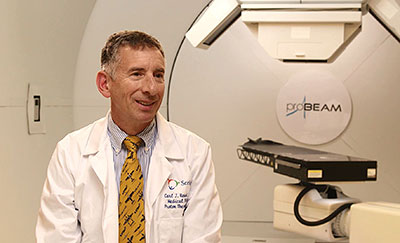 Carl J. Rossi, Jr., MD, Medical Director, Scripps Proton Therapy Center, La Jolla, CA
Carl J. Rossi, Jr., MD, Medical Director, Scripps Proton Therapy Center, La Jolla, CA
Adaptive radiotherapy describes the process by which a patient's treatment plan can be changed or "adapted" as necessary during the course of their treatment. This can mitigate changes in the patient's anatomy due to events like weight loss, tumor motion or shrinkage, and differential organ motion. The need for, and benefits of, adaptive techniques has been well-known and exhaustively researched in radiation therapy, but to date the implementation of adaptive techniques has been relatively limited, largely due to technology and workflow challenges.
The integration of adaptive techniques into treatment with intensity-modulated proton therapy (IMPT) affords clinicians the opportunity to change the delivery of the proton beam treatment plan to create a personalized, time sensitive, treatment approach for every patient. Additionally, employing adaptive radiotherapy allows for the treatment of a substantially greater range of cancer diagnoses and presentations with proton therapy, giving physicians more treatment options when determining their treatment. It is particularly useful in treating those anatomic regions which are subjected to substantial tumor and normal organ motion such as the lungs and upper abdomen.
Recent advancements in high quality volumetric imaging using cone-beam computed tomography (CBCT), deformable registration, and dose tracking have greatly advanced adaptive proton therapy implementation. Clinicians can now track interfractional changes both visually from high quality CBCTs acquired prior to treatment and by tracking the real dose delivered that day. With the combined understanding of the geometrical changes along with calculated day-to-day dose delivered, clinicians can calculate, for example, regions of overdose or underdose in the tumor volume, bringing about for the first time plan adaptations based on what was historically delivered to meet the initially intended prescription.
Improved Technology
Adaptive radiotherapy for proton treatment has been around in one form or another for decades; however, recent technological advances such as in-room CBCT, integrated software workflows between information systems and treatment planning systems, and pencil-beam scanning(PBS) have greatly improved adaptive radiotherapy for IMPT.
On April 18, 2016, Scripps Proton Therapy Center (SPTC) became the first facility to use the fully-integrated CBCT on the ProBeam System to image patients in the treatment room on a daily basis to see if there were any changes in a patient's anatomy or tumor that might "trigger" a diagnostic CT scan. Without in-room CBCT, proton therapy centers have to move a patient from the treatment room to a CT scanner in another room or building to check for changes in the anatomy or tumor.
CBCT not only serves as a "trigger" for replanning, but also for daily positioning. Unlike orthogonal X-rays, CBCT images give clinicians additional data regarding soft tissue, which is helpful in determining the optimal position for patients and for observing changes in tumor and normal tissue anatomy. This is especially critical in proton therapy where positioning that's off by 4 or 5 millimeters can have a profound effect on treatment.
Along with CBCT, PBS helps us quickly design a more precise treatment plan as a patient's clinical condition changes. Prior to PBS, passive scatter systems had been used for about 50 years. If the treatment plan needed to be changed, any change in the treatment plan which was desired by the clinicians had to rely upon physically manufactured blocks to shape the proton beam to match the shape of the target, a process which could, and often did, take days. With PBS, once the treatment plan is updated and approved, the proton beam can be delivered immediately.